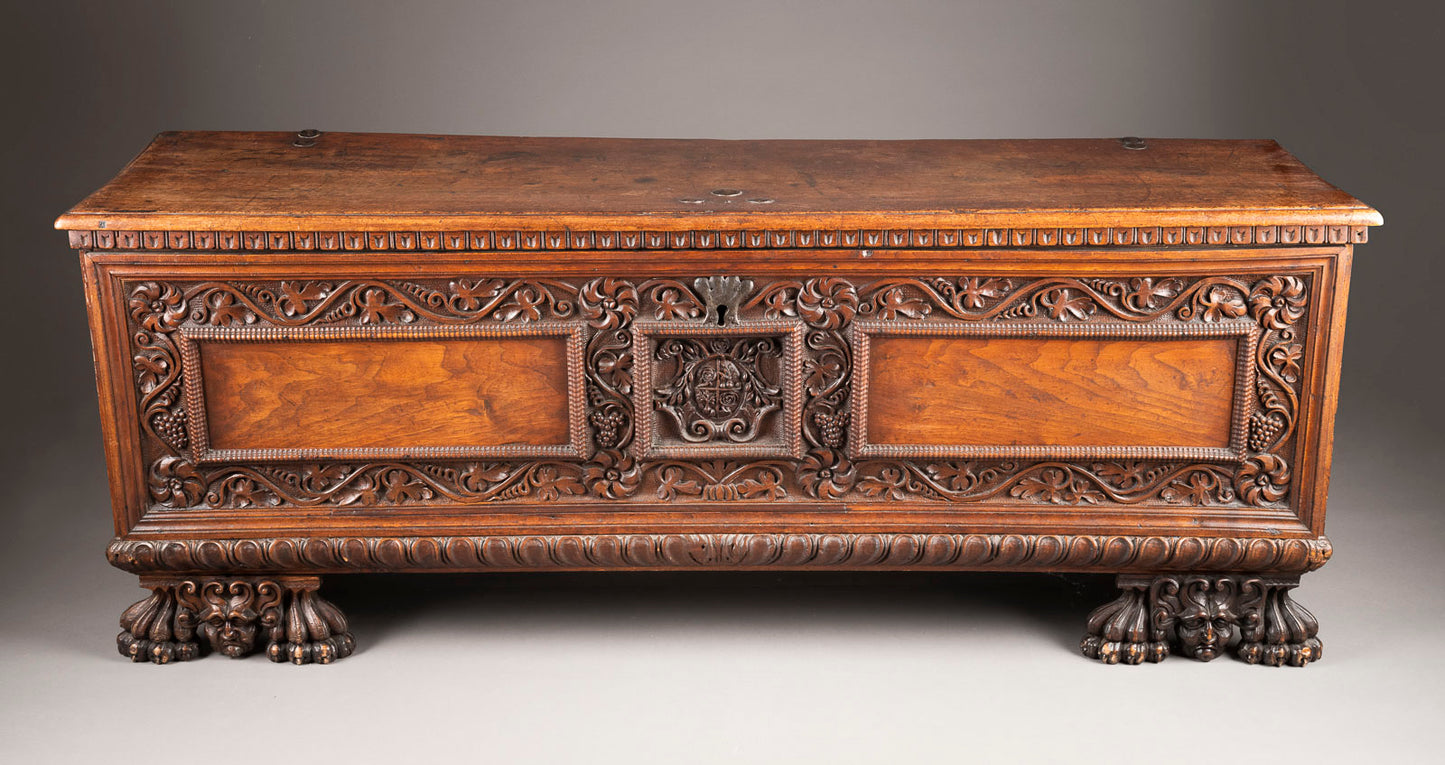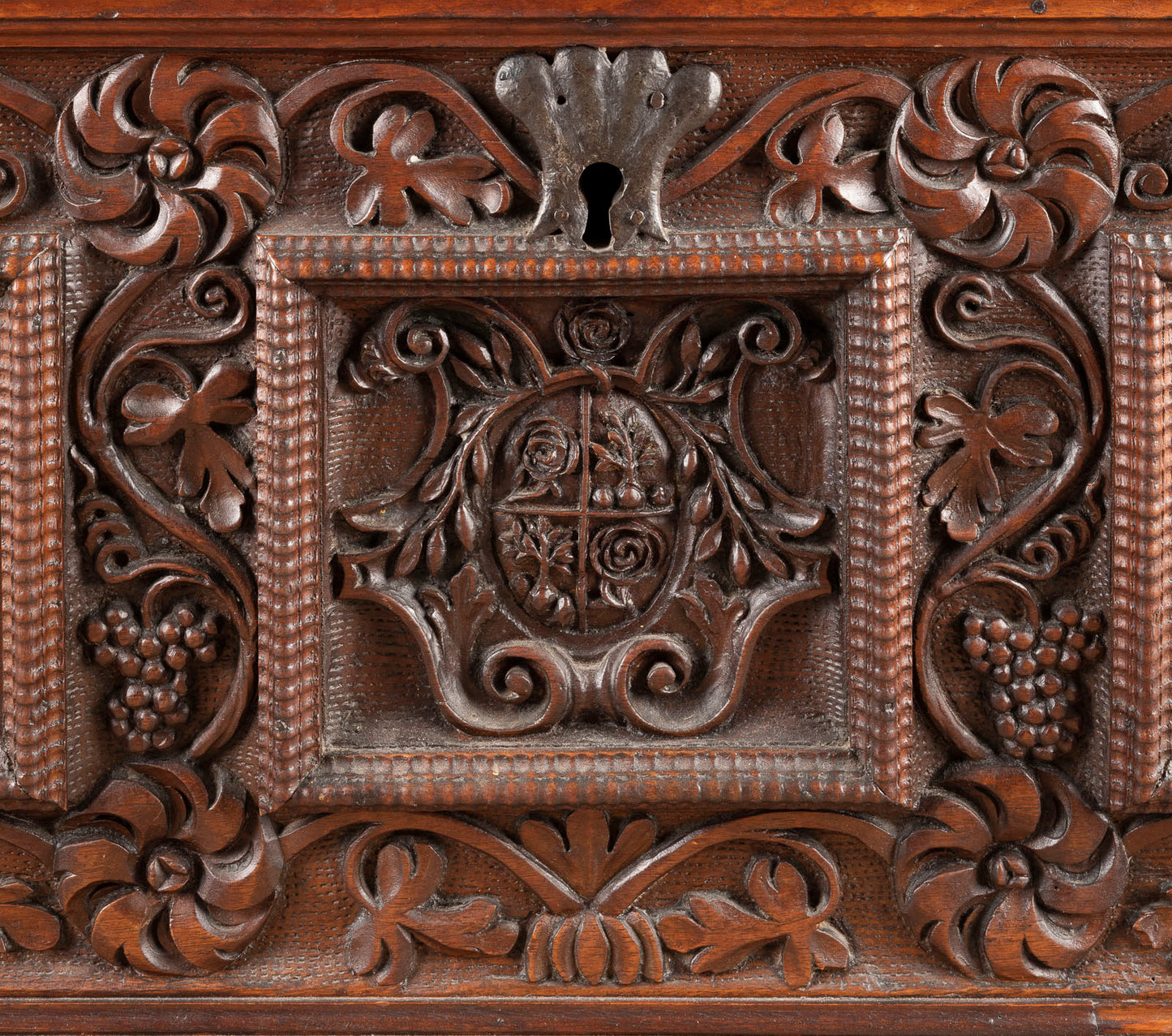My Store
Italian Walnut Cassone Renaissance Trunk c.1600 - Antique Marriage Chest
Italian Walnut Cassone Renaissance Trunk c.1600 - Antique Marriage Chest
Couldn't load pickup availability
An Italianate Imposing Solid Walnut Cassone/Trunk
An exceptional and museum-quality Italian Renaissance cassone (marriage chest) crafted from solid walnut, circa 1600. This imposing piece exemplifies the finest Italian furniture-making traditions of the late Renaissance period, combining substantial construction, beautiful walnut grain, and the historical significance of the cassone form. With its impressive presence and authentic period character, this cassone represents an extraordinary acquisition opportunity for collectors of Renaissance furniture, Italian antiques, or those seeking historically significant pieces that combine beauty, craftsmanship, and cultural importance.
The Cassone - Italian Renaissance Tradition
The cassone (plural: cassoni) represents one of the most important and distinctive forms of Italian Renaissance furniture. These large chests served primarily as marriage chests, given to brides as part of their dowry to store linens, clothing, and household goods. Cassoni held profound cultural significance in Renaissance Italy, often commissioned by wealthy families and decorated by important artists. The chests' fronts frequently featured elaborate paintings, carved decoration, or inlaid work depicting mythological, historical, or allegorical subjects. Cassoni document Renaissance domestic life, artistic patronage, and social customs while representing some of the finest furniture craftsmanship of the period.
Solid Walnut Construction - Premium Material
Crafted from solid walnut, this cassone demonstrates the use of premium materials characteristic of important Renaissance furniture. Walnut was highly prized in Italian furniture-making for its beautiful grain, rich color, workability, and durability. The wood's natural beauty required less elaborate decoration, allowing the material itself to be the primary aesthetic element. Solid construction (as opposed to veneered) indicates substantial investment in materials and ensures the piece's longevity. After 400+ years, the walnut has developed the warm patina and character that only centuries of careful preservation can create.
Circa 1600 Dating - Late Renaissance
The circa 1600 dating places this cassone at the transition between the Renaissance and Baroque periods, when Italian furniture-making had achieved extraordinary sophistication. By 1600, Italian craftsmen had perfected techniques developed over centuries, creating furniture of exceptional quality and beauty. This period saw the continuation of Renaissance forms like the cassone while anticipating the more elaborate Baroque aesthetic that would emerge in the 17th century. Furniture from this transitional period combines Renaissance restraint with increasing decorative richness.
Imposing Presence - Substantial Scale
Described as imposing, this cassone offers substantial size that creates commanding presence and demonstrates its original purpose as important household furniture for wealthy families. Large cassoni were status symbols, their size reflecting the family's wealth and the bride's dowry value. The impressive scale makes this cassone suitable as focal point in grand interiors while its substantial construction ensures stability and durability. Scale dramatically enhances both visual impact and historical authenticity.
Italian Craftsmanship - Technical Excellence
This cassone demonstrates the exceptional craftsmanship that made Italian Renaissance furniture renowned throughout Europe. Italian furniture-makers (legnaioli) were organized into guilds that maintained high standards and passed down techniques through generations. The cassone's construction likely employs traditional joinery techniques - mortise and tenon joints, dovetailing, and hand-forged hardware - that ensured structural integrity while allowing for the wood's natural movement. This traditional craftsmanship, combined with quality materials, explains how the cassone has survived four centuries in functional condition.
Historical and Cultural Significance
Beyond its aesthetic and material value, this cassone embodies Renaissance Italian culture, social customs, and domestic life. Marriage chests represented the intersection of family wealth, artistic patronage, and social ritual. They documented alliances between families, displayed wealth and taste, and provided practical storage for the bride's possessions. Owning a cassone means possessing tangible connection to Renaissance life and the customs that shaped Italian society. This cultural dimension adds depth to the piece's significance beyond mere furniture.
Patina and Character
After more than 400 years, this cassone has developed the authentic patina and character that only time can create. The walnut's color has deepened and mellowed, the surface shows honest wear from centuries of use, and the overall character documents the piece's long history. This patina cannot be artificially replicated and represents one of antique furniture's most valued characteristics. Collectors prize this authentic age-related character as evidence of genuineness and historical continuity.
Condition and Preservation
As furniture potentially 420+ years old, condition assessment is crucial. The cassone's survival in functional condition represents remarkable preservation. Any repairs, replacements, or alterations should be documented and evaluated by furniture conservation professionals. Many Renaissance cassoni show evidence of period repairs or later modifications, which add to rather than detract from their historical interest when appropriately disclosed. Detailed condition reports available to serious collectors.
Versatility and Modern Use
While created as marriage chest, this cassone serves beautifully in modern homes for various purposes - blanket chest, storage for linens or textiles, coffee table (with protective glass top), display piece, or simply as sculptural furniture celebrating Renaissance craftsmanship. The piece's substantial construction and timeless design ensure it works in both traditional and contemporary interiors. This versatility, combined with historical significance, makes the cassone attractive to both antique collectors and those seeking distinctive functional furniture.
Investment Value and Collectibility
Authentic Renaissance cassoni in solid walnut represent solid investment opportunities in the antique furniture market. The combination of circa 1600 dating, Italian origin, solid walnut construction, imposing scale, and the cassone form's historical significance creates strong appeal among collectors of Renaissance furniture, Italian antiques, and historically important decorative arts. As authentic period pieces become scarcer and appreciation for Renaissance craftsmanship continues, quality examples show consistent market performance.
Provenance and Authentication
Authentication of Renaissance furniture requires expert examination of construction techniques, materials, tool marks, hardware, and overall character. Comprehensive provenance research, technical analysis, and expert authentication available to serious collectors. Understanding the cassone's history, previous ownership, and scholarly documentation enhances both historical interest and market value. Period furniture with clear provenance commands significant premiums.
Display and Presentation
This cassone's imposing presence makes it suitable as focal point in various settings - entrance halls, living rooms, bedrooms, or anywhere its historical significance and beauty can be appreciated. The piece works beautifully in both grand period interiors and contemporary spaces where its Renaissance character creates dramatic contrast. Proper placement on stable floor and appropriate climate control essential for preservation. The cassone's substantial weight requires careful handling during placement.
Cultural Heritage and Collecting
This cassone represents Italian cultural heritage and the Renaissance period's extraordinary artistic and craft achievements. It embodies the era's sophisticated domestic culture, the importance of marriage alliances, and the integration of art and function that characterized Renaissance life. For collectors of Italian antiques or Renaissance decorative arts, this cassone offers opportunity to own authentic piece of this remarkable period.
Collecting Context
This cassone appeals to collectors of Renaissance furniture, Italian antiques, marriage chests, walnut furniture, and those seeking historically significant pieces combining beauty, craftsmanship, and cultural importance. It would enhance private collections, corporate holdings, institutional acquisitions, or serve as centerpiece in interiors celebrating Renaissance art and culture.
Available for viewing by appointment at Artemisia Fine Arts & Antiques Ltd, Malta. We provide expert consultation, authentication services, conservation coordination, provenance research, insurance valuation, and international shipping with specialized antique furniture handlers. This Renaissance cassone represents an exceptional acquisition opportunity. Serious inquiries from qualified collectors welcome.
Share






